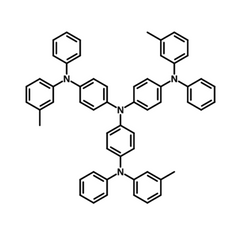m-MTDATA
CAS Number 124729-98-2
Electron / Hole Transport Layer Materials, High Purity Sublimed Materials, Host Materials, Materials, Perovskite Interface Materials, Perovskite Materials, Semiconducting Molecules
m-MTDATA, effective HIL material to lower driving voltage of OLED devices
Available online for priority dispatch
With its very low solid-state ionisation potential and good-quality amorphous film, 4,4',4''-Tris[phenyl(m-tolyl)amino]triphenylamine, m-MTDATA acts as an effective material for the hole-injection buffer layer (HIL) that facilitates hole injection from the ITO electrode to the hole transporting layer (HTL). This potentially lowers the driving voltage of the OLED devices.
F4-TCNQ, a strong electron acceptor, is always used together with m-MTDATA as a p-doping material to improve the conductivity of the HTL buffering layer. Typical structure of the device (or part of the device) is ITO/p-doped m-MTDATA/HTL/etc.
General Information
| CAS number | 124729-98-2 |
|---|---|
| Chemical formula | C57H48N4 |
| Molecular weight | 789.02 g/mol |
| Absorption | λmax 312 nm, 342 nm in THF |
| Fluorescence | λem 425 nm in THF |
| HOMO/LUMO | HOMO 5.1 eV, LUMO 2.0 eV [1] |
| Synonyms | 4,4',4''-Tris[(3-methylphenyl)phenylamino]triphenylamine |
| Classification / Family | Triphenylamine derivatives, Hole-injection materials, Hole transporting materials, Light-emitting diodes, Organic electronics |
Product Details
| Purity | Sublimed* >99.0% (HPLC) |
|---|---|
| Melting point | 210 °C |
| Appearance | Yellow/white powder |
*Sublimation is a technique used to obtain ultra pure-grade chemicals. For more details about sublimation, please refer to the Sublimed Materials.
Chemical Structure

Device Structure(s)
| Device structure | ITO/MoOx (2 nm)/m-MTDATA: MoOx (30 nm, 15 wt.%)/m-MTDATA (10 nm)/Ir(ppz)3 (10 nm)/CBP:PO-01* (3 nm, 6 wt.%)/Ir(ppz)3 (1 nm)/DBFDPOPhCz*:FIrpic (10 nm,10 wt.%)/Bphen (36 nm)/LiF (1 nm)/Al [3] |
|---|---|
| Colour | White |
| Max. EQE | 12.2% |
| Max. Current Efficiency | 42.4 cd/A |
| Max. Power Efficiency | 47.6 lm W−1 |
| Device structure | ITO/[F4-TCNQ(x nm)/m-MTDATA(y nm)]n/NPB/Alq3/Bphen/Cs2CO3/Al [4] |
|---|---|
| Colour | Green |
| Max. Luminance | 23,500 cd/m2 |
| Max. Current Efficiency | 7.0 cd/A |
| Max. Power Efficiency | 4.46 lm W−1 |
| Device structure | ITO/PEDOT:PSS(40nm)/m-MTDATA:Ir(Flpy-CF3)3 (40nm)/TmPyPB(55nm)/LiF(0.5nm)/Al(100nm) [5] |
|---|---|
| Colour | Yellow |
| Max. EQE | 25.2% |
| Max. Luminance | 43,085 cd/m2 |
| Max. Current Efficiency | 74.3 cd/A |
| Max. Power Efficiency | 97.2 lm W−1 |
| Device structure | ITO/PEDOT:PSS/m-MTDATA (20 nm)/m-MTDATA:3TPYMB (60 nm)/3TPYMB (10 nm)/LiF (0.8 nm)/ Al (100 nm) [6] |
|---|---|
| Colour | Red |
| Max. Luminance | 17,100cd/m2 |
| Max. Current Efficiency | 36.79 cd/A |
| Device structure | ITO (80 nm)/m-MTDATA (20 nm)/NPB (20 nm)/[ADN:Alq3 (4:1)]:1wt.% DCJTB:0.2wt.%C545T/Alq3 (30 nm)/LiF (1 nm)/Al (100 nm) [7] |
|---|---|
| Colour | Red |
| Max. Luminance | 11,600 cd/m2 |
| Max. Current Efficiency | 3.6 cd/A |
| Device structure | ITO/m-MTDATA*:F4-TCNQ (100 nm)/TPD (5 nm)/Alq3 (20 nm) /BPhen (10 nm)/ Bphen:Li (30 nm)/LiF (1 nm)/Al (100 nm) [8] |
|---|---|
| Colour | Green |
| Max. Luminance | 10,000 cd/m2 at 5.2 V |
| Max. Current Efficiency | 5.27 cd/A |
| Device structure | ITO/m-MTDATA (30 nm)/NPB (20 nm)/TPBI:4 wt% Ir(ppy)3:2 wt%Ir(piq)2(acac) (30 nm)/Alq3(20 nm)/LiF/Al [9] |
|---|---|
| Colour | White |
| Max. Luminance | 33,012 cd/m2 |
| Current Efficiency@100 cd/m2 | 15.3 cd/A |
| Max. Powder Efficiency | 10.7 lm W−1 |
| Device structure | ITO/m-MTDATA/TPD/F-TBB*/Alq3/MgAg [10] |
|---|---|
| Colour | Blue |
| Max EQE | 1.4% |
| Maximum luminance | 3960 cd m-2 at 15.0 V |
*For chemical structure information please refer to the cited references.
Pricing
| Grade | Order Code | Quantity | Price |
|---|---|---|---|
| Sublimed (>98.0% purity) | M621 | 250 mg | £155 |
| Sublimed (>98.0% purity) | M621 | 500 mg | £250 |
| Sublimed (>98.0% purity) | M621 | 1 g | £420 |
MSDS Documentation
Literature and Reviews
- Nanoscale transport of charge-transfer states in organic donor–acceptor blends, P. B. Deotare et al., Nat. Mater., 14, 1130-1135 (2015). DOI: 10.1038/NMAT4424.
- Photophysical Investigation of the Thermally Activated Delayed Emission from Films of m-MTDATA:PBD Exciplex, D. Graves et al., Adv. Funct. Mater., 24, 2343–2351 (2014). DOI: 10.1002/adfm.201303389.
- Highly efficient and color-stable white organic light-emitting diode based on a novel blue phosphorescent host, Q. Wu et al., Syn. Metals 187, 160– 164 (2014). http://dx.doi.org/10.1016/j.synthmet.2013.11.010.

 m-MTDATA MSDS sheet
m-MTDATA MSDS sheet